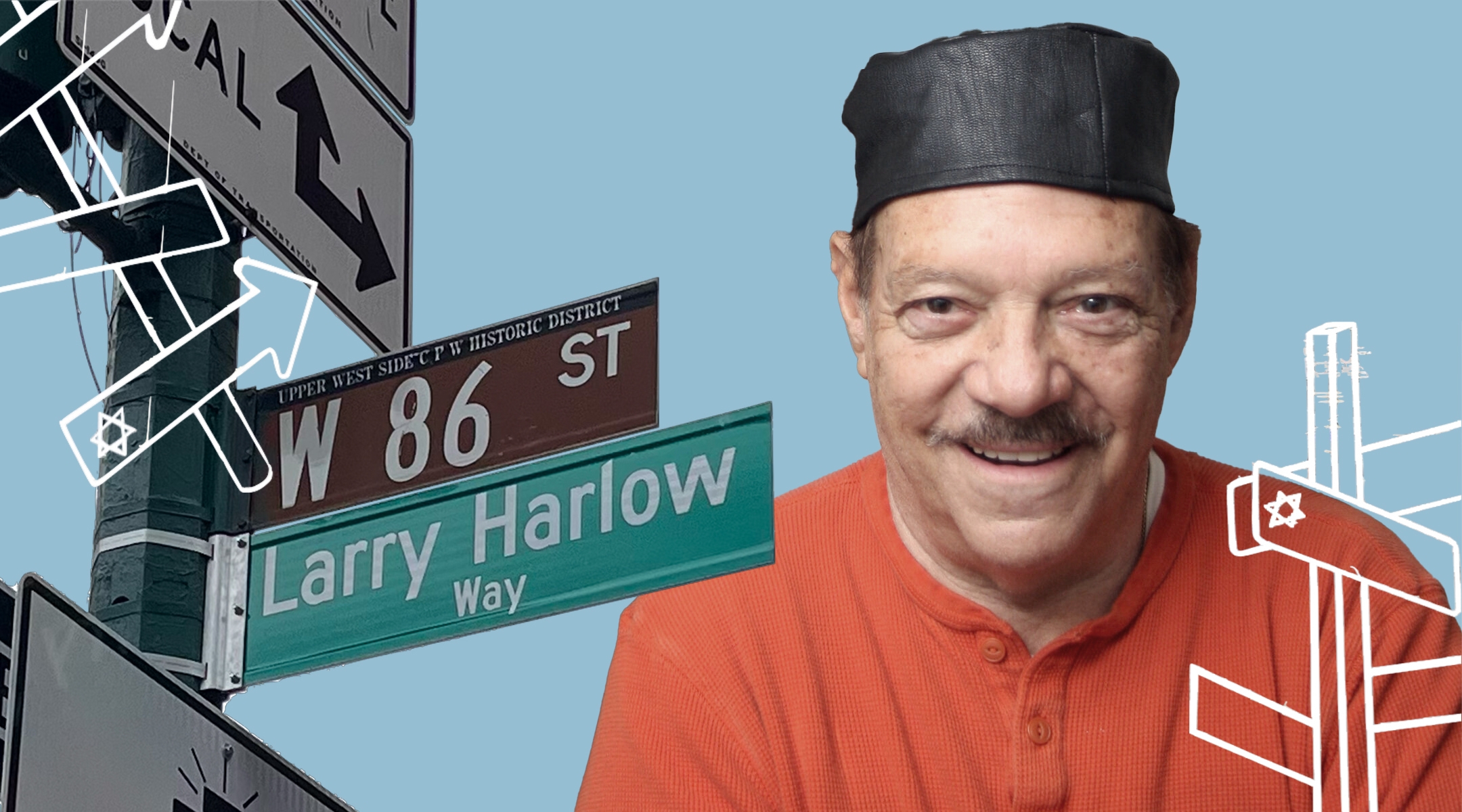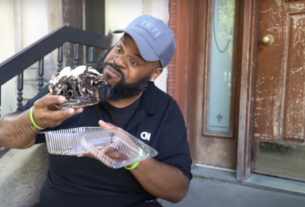Between showers on a rainy Sunday afternoon, an Upper West Side intersection played host to a lively outdoor salsa concert by a 13-piece band that included three trumpet players and three trombonists.
The street party, which drew a mix of dancing celebrants and confused passersby, was in honor of the Jewish New Yorker who left an indelible mark on salsa music, despite his lack of Latin American roots.
And now, the corner of Columbus Avenue and West 86th Street will bear the name of the legendary salsa musician who lived on the block for nearly 50 years: Larry Harlow.
The concert was part of a ceremony that unveiled a new, co-named New York City street, Larry Harlow Way, honoring the multi-instrumentalist, bandleader, composer and producer who was known in the Latin music world and beyond as “El Judio Maravilloso,” or “The Marvelous Jew.”
Harlow, who died in 2021, was born Lawrence Ira Kahn in 1939. He grew up in the Brownsville section of Brooklyn, raised by a family of musicians. His paternal grandfather was the theater critic for the Jewish Daily Forward.
After beginning piano lessons at 5 years old and excelling in a number of instruments, he attended the High School of Music and Arts in Harlem — an experience that led him to discover the music that would shape his life.
“When I got out of the subway, I would walk up this huge hill and hear this strange music coming from all the bodegas,” Harlow told the Forward in a 2006 interview. “I thought, ‘What kind of music is this? It’s really nice.’”
That curiosity led him to buy a one-way ticket to Cuba in the 1950s; there, he traveled the country by bus and studied the music scene. His trip was cut short by the outset of the Cuban Revolution. But after returning to the U.S., he would go on to become one of the most prolific artists of Fania Records, the quintessential New York-based salsa and Latin label, recording more than 200 albums by various artists and 50 of his own.
And so, when it came time to honor Harlow Sunday, it was only fitting to do so by captivating a crowd with a salsa performance, played by a band of musicians who’d all performed with Harlow over the last five decades. Fortunately, the forecasted rain held off just long enough for the concert to go off without a hitch. (“Rain or shine, it’s Larry Harlow time!” Maria Barreto, an event organizer and radio host, declared as the band started.)
Many Sunday-strolling Upper West Siders stopped to admire the large band that had taken over the corner; well over 100 people squeezed into the surrounding sidewalk. Some salsa danced and sang along to the Spanish lyrics; others simply swayed to the rhythm. Very few were standing still.
The band played some of Harlow’s most notable songs, like “La Cartera” and “Arsenio,” a song that paid tribute to Arsenio Rodriguez, a blind Afro-Cuban musician who’d died in 1970. Grammy Award-winning artist Marlow Rosado had flown in from Miami to play keys and honor Harlow.
“I have seldom seen the diversity of the love of somebody who’s both Jewish — Upper West Side — but also internationally known,” said Gale Brewer, the neighborhood’s representative in City Council, who spoke ahead of the performance. “And for us in the neighborhood, that’s a big deal — to have someone that’s so beloved and so talented, and was beloved by family and friends, but also by the musicians, by the people who understand real music.”
Barreto, who had been a fan of Harlow’s before befriending him, played a key role in the nearly year-long process of making the street naming a reality. The fact that he was Jewish, she said, made Harlow “even more fascinating.”
“To see someone who’s Jewish — wait a minute — who went to Cuba, who studied music over there, who has traveled around the country, and created something that has moved everybody?” she told the New York Jewish Week. “It’s a beautiful thing.”
Harlow’s widow, Maria Harlow-Kahn, whose last name is a combination of Larry Harlow’s legal and stage surnames, spoke before the concert, which preceded the unveiling of the actual street sign.
“I stand here today filled with gratitude and emotion as we unveil a lasting tribute to my beloved husband,” Harlow-Kahn said. “Now his name will live on, right here, where he walked, dreamed and created — his beloved Upper West Side.”
Barreto said that Harlow-Kahn had reached out to her some time after her husband’s death, asking about ways to pay tribute to him.
One of the suggestions Barreto thought of was with a street co-naming. The process requires going through multiple rounds of approval, including from the local community board and City Council. Applicants must also provide evidence of the person’s importance to the community. To that end, Barreto recalled standing on West 86th St. and asking pedestrians if they knew Larry Harlow.
“Many, they would start singing some of his songs — now that was amazing,” she said. “Some would say, ‘Ooh, I remember where I saw him,’ they would say what club, what venue they were at.”
Others, Barreto said, had not heard of him. “They’d say, ‘Let me Google him,’ and they’re like ‘Oh my God, I’m a pianist, I should get to know who this guy was!’”
And that, Barreto said, made the idea of Harlow’s name being immortalized on a highly visible street sign, all the more impactful. “It’s a way to inspire the next generation of musicians, artists and community,” she said. “Because it’s culture — and that’s what it’s about.”
Jewish stories matter, and so does your support.




